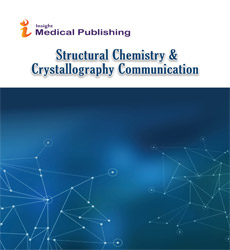Abstract
Stereochemistry and Anti-Inflammatory Inhibition: Asymmetry, And Complexes Of 4-Halogenated Mofebutazones Derivatives
The role of halogens in racemic 4-hal-4-butyl (n-octyl)-1phenyl derivatives (hal: F, Cl, Br), of the cyclic pyrazoline(1,3)-diones in the solid state and in solution was determined [1]. Noncovalent interactions are observed for the F, Cl and Br derivatives between the halogen atom and the hydrogen atom of the nitrogen of the pyrazolidine ring, water hydrogens that interact either with the halogen atoms or with the carbonyl oxygen atoms very different from the none-halogenated pyrazoline-diones [2-5]. The 3d and 2d structures are stabilized by ïÂÂÂÃâð-ïÂÂÂÃâð and ïÂÂÂÃâð-ïÂÂÂÃâð interactions, intermolecular distances, and apolar forces between adjacently stacked phenyl rings. However, the R-or S-enantiomers or their water-stable complexes with Znmeglumine did not racemizes in aqueous dispersions [1,3]. Small-angle-, wide-angle x-ray scattering experiments, and molecular simulation reveal similar solution structure factors, S(Q), in the solid state and in solution [6,7]. The planes and their periodicities of the crystalline phases are preserved in the aqueous solution phase. There is also hydrogen bonding formed in the racemic and the R-enantiomeric n-octyl-1phenyl-1-Cl-pyrazoline-(1,3)-dione between the hydrogens of the water molecules and the halogens of the pyrazolidine ring: Cl forms a hydrogen bond to the water hydroxy group of a neighbouring molecule, which is hydrogen bonded to the chlorine of another molecule forming a 1-dimensional hydrogen-chloride bond network differently from hydrated cationic lipids or their polymorphs [8,9]. The n-octyl pyrazolidine approximant forms micelles in aqueous dispersions that selfassemble into quasicrystalline structures. The small-angle X-ray scattering experiments and the selected area electron diffraction pattern of thin films suggest that the micelle FCC phase transforms into a colloidal quasicrystalline phase with 12-fold symmetry that proceed through rearrangements of the micelles in the (111) layers of the FCC phase. The differences of the halogenated cyclic and non-cyclic pyrazoline diones are related to biochemical changes in anti-inflammatory activities. The n-octyl compound reveal antimicrobial and antiviral (influenza) activities but no anti-inflammatory or analgesic activities.
Author(s):
Abstract | PDF
Share this

Google scholar citation report
Citations : 275
Abstracted/Indexed in
- Google Scholar
- China National Knowledge Infrastructure (CNKI)
- Directory of Research Journal Indexing (DRJI)
- WorldCat
- Geneva Foundation for Medical Education and Research
- Secret Search Engine Labs
- CAS (Chemical Abstracting Services)
Open Access Journals
- Aquaculture & Veterinary Science
- Chemistry & Chemical Sciences
- Clinical Sciences
- Engineering
- General Science
- Genetics & Molecular Biology
- Health Care & Nursing
- Immunology & Microbiology
- Materials Science
- Mathematics & Physics
- Medical Sciences
- Neurology & Psychiatry
- Oncology & Cancer Science
- Pharmaceutical Sciences

